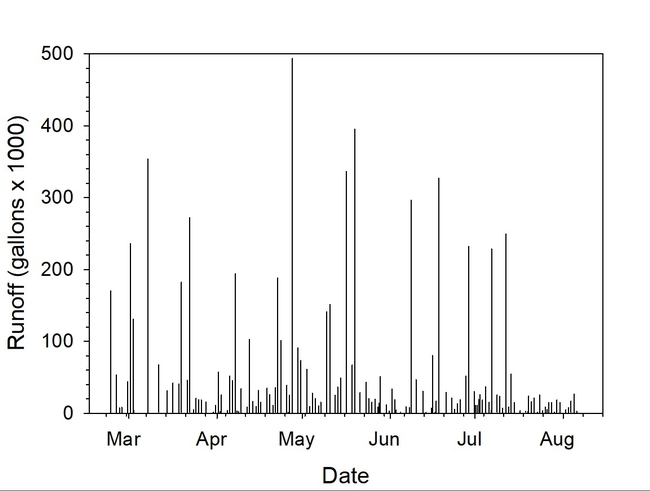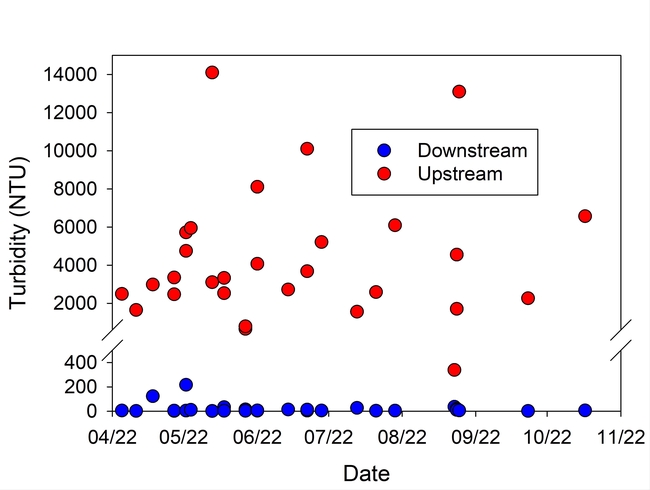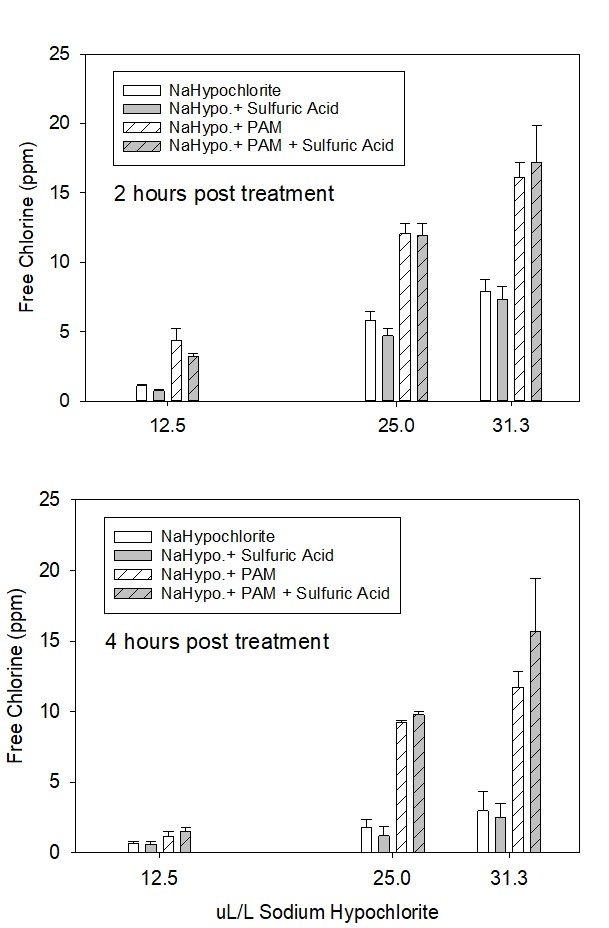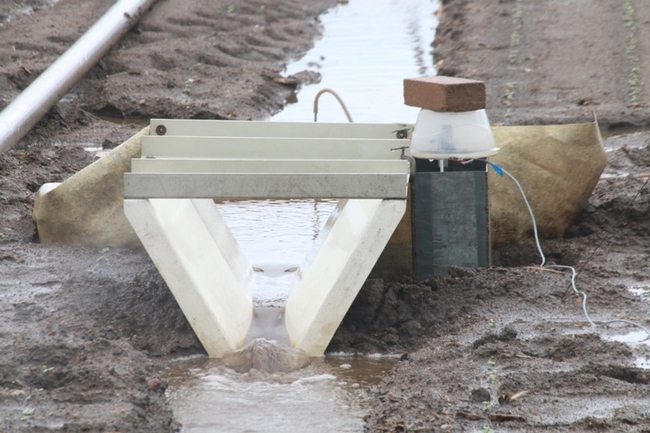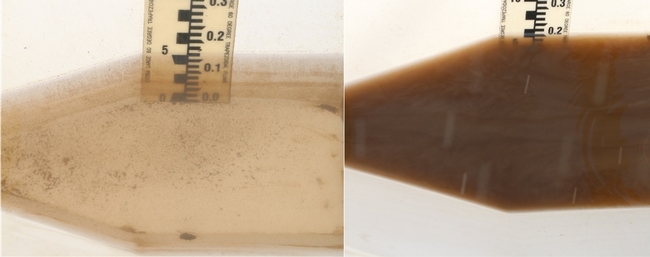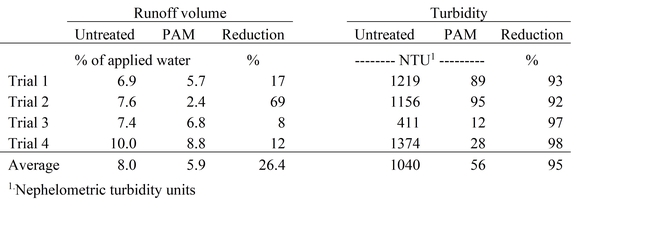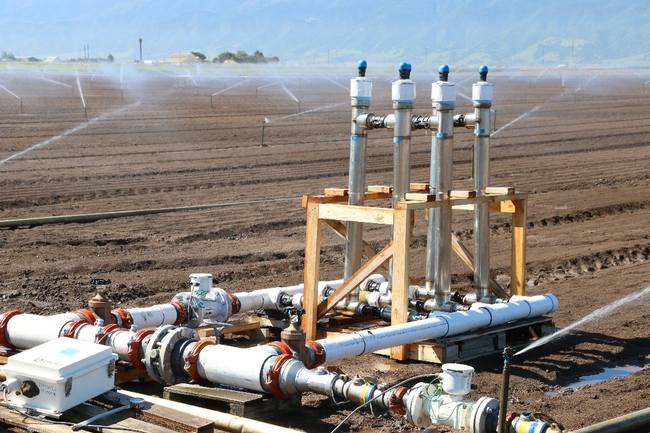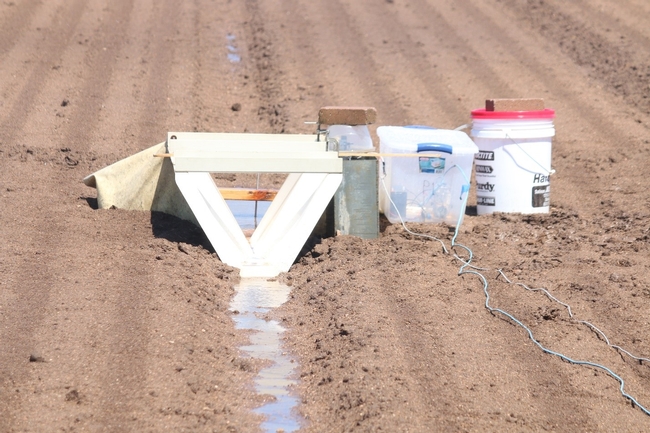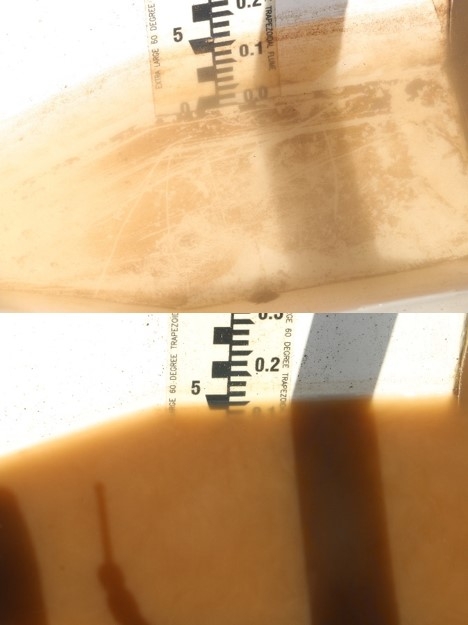- Author: Michael Cahn
- Contributor: David Chambers
- Contributor: Tom Lockhart
- Contributor: Noe Cabrera
Minimizing suspended sediments in irrigation runoff is desirable for several reasons. For growers reusing tailwater for watering their crops, they must assure that the water has minimal food safety risks by testing it for generic E coli and/or treating it with chlorine. The concentration of free (or reactive) chlorine is reduced when tailwater contains a high concentration of suspended sediments. Treating a large volume of tailwater with chlorine can be a significant expense over a season so it is important to be able to remove as much of the suspended sediments as possible before treatment.
A second reason is that water quality regulations under Agriculture discharge Order 4.0 requires tailwater discharged into public water ways to not be toxic to aquatic organisms. Pesticides that strongly bind to soil, such as pyrethroids, are carried on the suspended sediments in runoff which can cause toxicity to aquatic organisms that live in creeks and rivers downstream from farms. Also, particulate forms of N and P which bind with the suspended sediments pose a water quality risk to receiving waterbodies such as the sloughs and wetlands along the coast. Both nutrients can spur algal blooms which reduces dissolved oxygen available to fish and other aquatic organisms.
In a previous article we discussed a new approach to using Polyacrylamide (PAM), an inexpensive polymer molecule for reducing soil erosion, to treat sprinkler water. This practice uses a specialized applicator (Fig. 1) to condition water flowing from a well with PAM. An advantage of this method is that the cartridges in the applicator release a small amount of PAM (1 to 2 ppm) into the irrigation water, which flocculates soil particles that could potentially become suspended and transported in runoff. Field tests using a prototype version of this applicator resulted in about 90% less suspended sediment in the tailwater when treated with PAM compared to untreated irrigation water.
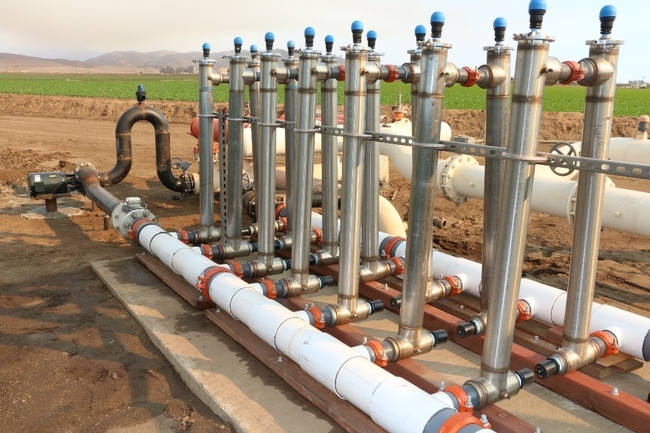
Auger ditch applicator
A second approach we developed for reducing suspended sediment in runoff is to use a smart applicator that can automatically apply dry PAM to the runoff water flowing in farm ditches. This type of applicator is suspended on a platform above a ditch and uses a hopper filled with dry PAM and an auger system controlled by an electric motor and small computer to drop PAM down a tube into the flowing runoff (Fig. 2). A weir and float mechanism located upstream are used to monitor the flow rate of the runoff so that the computer can adjust the frequency that PAM is applied. A video at this link demonstrates how the auger applicator operates.
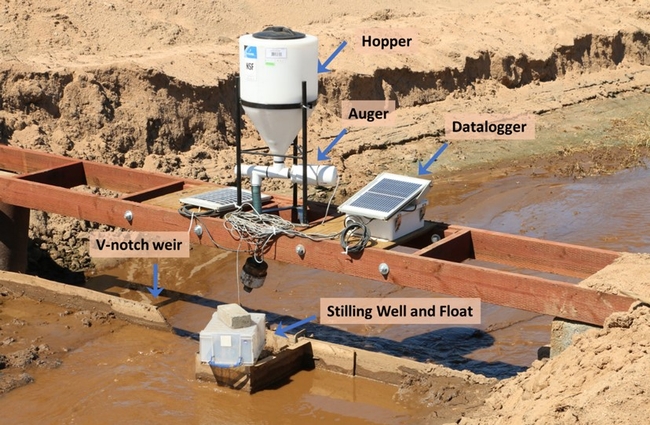
Field testing of the ditch applicator
A yearlong study at a commercial farm showed that the ditch applicator was effective in removing 98% of the suspended sediments transported in runoff (Table 1, Fig. 3). Based on the total runoff measured in a single drainage ditch during the 2022 season (21.5 acre-feet), an estimated 106 tons of sediment were removed (Fig. 4).
Turbidity in the runoff was reduced by more than 99%, and Total P and N were reduced on average by 89% and 60%, respectively, during the season (Table 1, Figs. 5 and 6). These reductions in nutrient load, suspended sediment, and turbidity could greatly improve water quality in water bodies downstream from farms that discharge irrigation runoff.
Table 1. Average concentration of N, P, and sediments carried in irrigation runoff before (upstream) and after (downstream) treatment with the PAM ditch applicator (April – October 2022). Average of 32 paired grab samples from 3 farm ditches. Downstream locations varied from 300 to 500 ft downstream from the PAM applicators.
Ditch applicator vs well applicator
Although more effective at reducing suspended sediment in runoff than the well applicator, the ditch applicator required more maintenance. PAM needed to be added to the hopper once or twice per week during the irrigation season, and sediment that settled in the ditches had to be cleaned out periodically using a backhoe. Also, removed sediment had to be spread back in the fields. The well applicator only required periodic refilling of the cartridges with PAM, and minimizes the amount of sediment that settles out in the drainage ditches.
PAM effects on chlorine requirement
To evaluate the effect of PAM on the quantity of chlorine needed to treat runoff, we performed a laboratory assay on samples of sprinkler runoff collected upstream and downstream of one of the ditch applicators. The turbidity of the upstream (untreated) and downstream samples (PAM treated) was 2276 and 9.5 NTU, respectively. The electrical conductivity of the runoff samples was 1.35 dS/m and the pH was 8.4 before adding chlorine. The main factors evaluated in the assay were sodium hypochlorite concentration and acidification with 10% sulfuric acid. Presumably, acidifying the runoff to a pH of 6.5 should increase the concentration of the more reactive form of chlorine, hypochlorous acid which is more effective as a microbial disinfectant. Residual free chlorine concentration of the treatments was evaluated 2 and 4 hours after adding 12.5% sodium hypochlorite at concentrations ranging 12.5 to 31.3 ul per liter of runoff (100 to 250 ul of 12.5% NaOCl per L of water).
The laboratory assay showed that reducing suspended sediment concentration using PAM increased the efficacy of chlorine treatment of runoff. The free chlorine concentration for PAM treated runoff was more than twice the concentration measured in the untreated runoff for all sodium hypochlorite concentrations evaluated after 2 hours and more than three times the concentration after 4 hours (Fig. 7). Free chlorine concentration in the PAM treated runoff was more than 2.5 ppm two hours after treatment at the lowest concentration of chlorine evaluated (12.5 ul/L) but was less than 0.5 ppm in the untreated runoff. To attain similar chlorine efficacy as PAM treated runoff, untreated runoff would require twice as much sodium hypochlorite (25 ul/L). These chlorine requirements would correspond to 26 and52 gallons of 12.5% sodium hypochlorite to treat and acre-foot of runoff with and without a PAM pretreatment, respectively.
Acidification of the runoff to a pH of 6.5 with sulfuric acid increased the free chlorine concentration in the PAM treated runoff at the highest concentration of sodium hypochlorite (31.3 ul/L) after 4 hours. Acidification did not have a significant effect on free chlorine concentration for the other treatments.
Summary
Both versions of the dry PAM applicators (well and ditch) show promise for greatly reducing soil erosion, as well as helping improve water quality and the efficacy of chlorine for treating tail water reused for irrigation. By considerably reducing the concentration of suspended sediment in irrigation runoff, chlorine can be more effective as a disinfection agent, and better control E. coli and other microbial pathogens that could potentially cause public health risks.
Acknowledgments: We greatly appreciate assistance in fabricating the prototype PAM applicators from RayFab. This project was funded by the California Leafy Green Research Board.
Further reading
- Author: Michael D Cahn
- Contributor: David Chambers
- Contributor: Thomas Lockhart
- Contributor: Noe Cabrera
As the drought continues on the central coast, growers are trying to utilize water as efficiently as possible to produce their crops. Retaining and reusing sprinkler runoff, also referred to as tail water, can be an important strategy to increasing water conservation. Also, retaining runoff prevents suspended sediments, pesticides and nutrients from impairing rivers and estuaries downstream of agricultural fields.
Many ranches in the Salinas Valley have retention basins and infrastructure that can capture runoff and reuse tail water for irrigating crops. Most growers use this water during the pre-germination or the germination stages to avoid food safety risks from microbial pathogens. However, updates to the leafy green marketing agreement (LGMA) now require that water stored in open reservoirs and used for irrigating leafy greens maintain generic E. coli levels less than 10 MPN/100 ml. In most cases, tail water in open reservoirs will need to be treated with chlorine to achieve this low threshold for generic E. coli. Fine sediments suspended in the tail water can greatly reduce the effectiveness of chlorine to control bacterial growth.
Polyacrylamide (PAM), an inexpensive polymer molecule that has been used for controlling soil erosion in furrow irrigated fields since the early 1990s may be able to improve the efficacy of chlorine by reducing the suspended sediment concentration in sprinkler runoff. Additionally, if runoff is discharged from a ranch, treatment with PAM can greatly reduce the concentration of sediment-bound pesticides and nutrients that can degrade water quality downstream. Past field trials that we conducted have shown that adding PAM to irrigation water at a low concentration (< 5 ppm) is an effective way to minimize erosion in sprinkler irrigated fields and remove suspended sediments from tail water. However, for this strategy to be successful with sprinklers, we found that PAM must be injected continuously throughout each irrigation. In other words, a single application of PAM cannot control suspended sediments in runoff during subsequent irrigations.
New approaches to using PAM
Accurately injecting PAM into a pressurized irrigation system is not a simple process. Dry PAM powder becomes very gooey and viscous when moistened, and is almost impossible to uniformly dissolve into water. Emulsified oil formulations of PAM that mix up uniformly in water are available but are more costly than dry PAM products and require sophisticated pumps to meter it into a pressurized irrigation system, as well as trained staff to assure that the application rate is accurate. Another limitation of liquid PAM is that the mineral oil used to emulsify these products can be toxic to aquatic organisms. In contrast, dry PAM is less than half the cost of liquid PAM and has been shown to have no toxicity to aquatic test organisms such as Hyalella azteca and Ceriodaphnia dubia, even at concentrations 20 times greater than would be typically used for treating irrigation water. Hence, for these reasons, we have been developing and evaluating approaches of using dry PAM to control sediment in sprinkler runoff during the last several years.
Treating pressurized irrigation water with PAM
The first method that we describe in this article uses an applicator to dissolve dry PAM into pressurized irrigation water. The applicator consists of cartridges filled with PAM granules that insert into a series of cylindrical chambers (Fig. 1). A small pump can be used to divert a portion of the irrigation water from the mainline into the inlet of the applicator. PAM slowly releases from the cartridges (Fig. 2) as irrigation water streams through the space between the cartridges and the outer walls of the chambers. Vanes surrounding the cartridges increase turbulence of the flowing water to maximize the dissolution of PAM. The treated water then returns into the main line of the irrigation system where it distributes into the field through the sprinkler system.
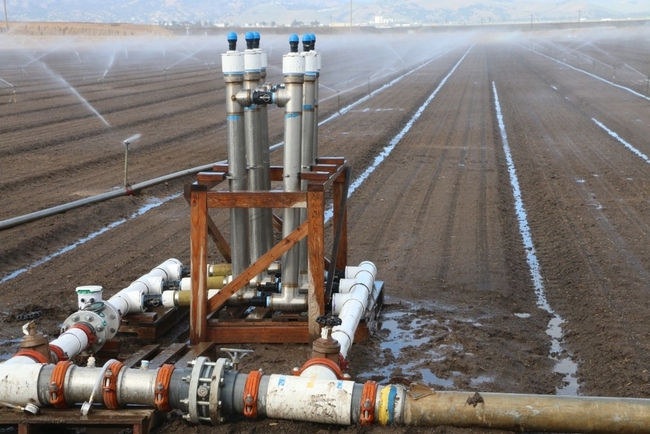
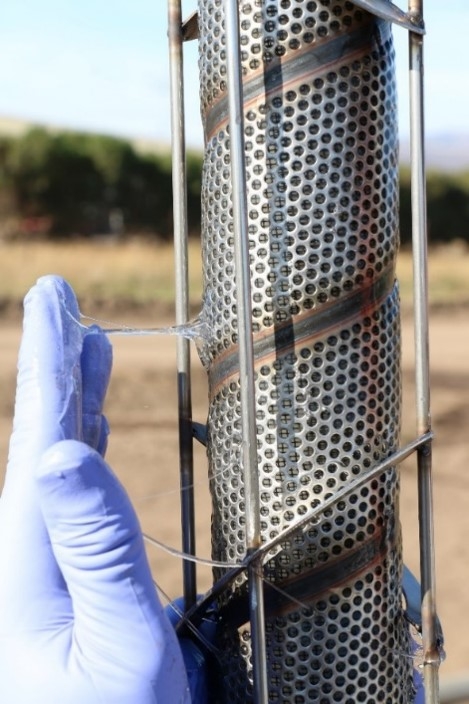
Field-testing the dry PAM applicator
Field-testing of the prototype PAM applicator was conducted in commercial lettuce fields during 2020 and 2021. Each field test occurred during the germination phase of the crop (5 to 6 consecutive irrigations) using overhead sprinklers. The fields were divided into untreated, and PAM treated areas, where the PAM treated plots ranged from 1.9 to 4.2 acres. Soil textures at the sites varied from loam to sandy loam. A portion of the flow in the main lines was diverted through the PAM applicator. Flowmeters were used to measure the flow rate in the mainline and the inlet of the applicator. Another flowmeter monitored the volume of water applied in an adjacent untreated plot.
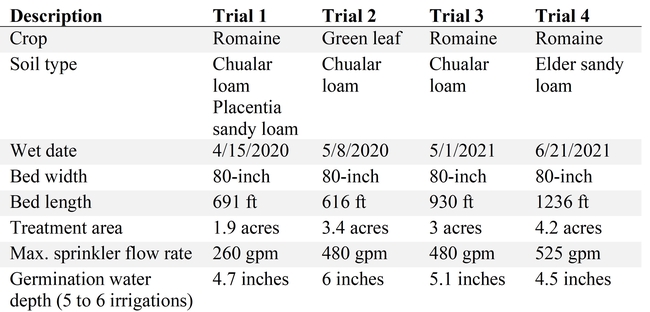
Flumes were installed 30 ft from the far end of the fields to measure run-off volume in the PAM treated and the untreated plots during the irrigations (Fig. 3). A stilling well and float mechanism were used to measure the height of the water in the flume. A datalogger recorded the height of the water in the flume and converted it to a flowrate using a calibration curve. The datalogger also automated sampling of run-off into collection containers using a peristaltic pump. Composite samples of run-off were collected from the plots during 5 to 6 irrigation events and analyzed for turbidity, pH, electrical conductivity, suspended sediments, total nitrogen (N), nitrate-N, total phosphate (P) and orthophosphate at the UC Davis analytical laboratory.
Results of field tests
The average concentration of suspended sediments in the untreated sprinkler runoff ranged from 466 to 1256 milligrams per liter (mg/L) during each trial (Table 2). Results of these field trials demonstrated that pretreating the irrigation water with the PAM applicator could reduce the concentration of suspended sediments carried in sprinkler runoff by 85% to 95%, depending on the soil type. The average reduction in suspended sediment concentration in the runoff was 90% across all trials. Turbidity of the runoff in the PAM treated plots was also reduced by an average of 95% across all sites (Fig. 4, Table 3). Runoff volume in the PAM treatment was reduced by an average of 26%, but the reduction in runoff volume varied from 8% to 67% depending on the site characteristics (Table 3).
Total and soluble phosphorus were reduced by an average of 65% and 14% respectively in the PAM plots compared to the untreated controls in the two trials conducted in 2021 (data not presented). Total nitrogen and nitrate nitrogen concentration in runoff from the PAM treated plots were not reduced compared to the untreated plots.
The combined effects of reduced runoff volume and suspended sediment concentration under the PAM treatment resulted in less loss of soil from these fields (Table 2). Soil erosion was reduced by an average of 93% compared to the untreated control, varying from 89% to 96% reduction in erosion among field sites. Cumulative losses of sediment during the germination phases of the crop were reduced from an average of 76 lbs per acre in the untreated plots to 5 lbs per acre in the PAM treated plots. The sediment lost in the untreated plots would equate to 15 tons for a 200-acre ranch that was planted with 2 crops of vegetables per season. This estimate is only for the germination phase of the crop and so total losses of sediment could be much higher for crops irrigated with sprinklers until harvest.
Potential soil health benefits
Improving soil structure and increasing soil organic matter may be an additional benefit of applying PAM to the field through the irrigation water and preventing the erosion of fine sediments. Much of the stable organic matter in soil is associated with the clay size particles, so preventing the erosion of these fine sediments would presumably help with retaining and building soil organic matter. Fine sediments and organic matter are also important in the development of better soil structure which can improve crop growth.
Summary
The dry PAM applicator that we field tested showed promise for greatly reducing soil erosion, as well as helping improve water quality. Presumably, by removing the sediment from the tail water, less chlorine would be required for controlling microbial pathogens. The six-unit PAM applicator tested in this study can treat up to 500 gpm. The applicator would need more mixing units to treat all the flow from a typical agricultural well in the Salinas Valley (flow rates of 1000 to 1500 gpm). To see a video showing runoff from PAM treated and untreated field plots during a sprinkler irrigation, follow this link. The second part of this article will discuss an additional method to use dry PAM to treat irrigation runoff. This second approach uses an applicator that directly treats runoff in drainage ditches.
Acknowledgments: We greatly appreciate assistance in fabricating the prototype PAM applicators from RayFab. This project was funded by the California Leafy Green Research Board.
- Author: Michael D Cahn
- Contributor: Thomas Lockhart
- Contributor: David Chambers
- Author: Gerry Spinelli
Background
Pyrethroid pesticides strongly bind to suspended sediments carried in agricultural runoff and have been identified as a source of aquatic toxicity on the central coast by both the Central Coast Regional Water Quality Control Board and the California Department of Pesticide Regulation. Sprinkler irrigation of vegetable crops often results in significant volumes of runoff, especially during the germination and stand establishment phase. Unless growers can contain agricultural runoff on their ranches, mitigation practices are needed to minimize downstream water quality impacts.
Polyacrylamide has been shown to minimize erosion in furrow irrigated fields. Several field studies that we conducted more than 10 years ago also demonstrated that long chained anionic polyacrylamides can be used in pressurized sprinkler systems to minimize sediment losses from vegetable fields. These studies concluded that maintaining a concentration of 2.5 to 5 ppm PAM in the water during an irrigation can reduce sediment concentrations in run-off by more than 90%. These studies showed that the best method for injecting PAM into pressurized irrigation systems was to use a liquid formulation and a specialized metering pump developed for viscous liquids. Although the pump was relatively easy to use, it was expensive ($3500 per pump) and required that irrigators received training on how to operate the pump and correctly dose the irrigation water. In addition, the liquid formulation of PAM, which was emulsified with mineral oil, was more than twice the cost of dry granular formulations ($4/lb vs. $2/lb). The total cost for treating with PAM was estimated at $26 to $34/acre using the liquid formulation for four irrigations (Cahn 2006).
Another issue identified for liquid formulations of PAM was potential aquatic toxicity. Although research studies have shown that anionic PAM is not toxic to aquatic organisms, the mineral oil use to emulsify liquid PAM products was shown to have toxicity to Ceriodaphnia dubia and Hyalella azteca, both of which are test organisms used to evaluate aquatic toxicity. Although other liquid formulations of PAM using humectant ingredients were shown to be non-toxic to aquatic organisms and effective in controlling sediment (Cahn and Farrara 2009), they were more expensive and less widely available than the mineral oil-based formulations.
The solid tablet and granular forms of PAM are easier to handle than liquid formulations and cheaper but dissolving these forms of PAM at a rate sufficient to provide an efficacious concentration in a pressurized irrigation system is challenging. Rather than dissolving uniformly into solution tablet and granular forms of PAM tend to form clumps when added to water and require prolonged agitation to dissolve uniformly.
A new type of PAM applicator
During the past two years we designed, and field tested several prototype applicators that can add dry forms of PAM (tablet or granular) at a low but consistent rate in pressurized irrigation systems.After several modifications we settled on a design that maximized the efficiency of dissolving dry forms of PAM into flowing pressurized irrigation water. The current applicator consists of cartridges filled with PAM that insert into a series of six stainless steel cylindrical chambers (Fig. 1). A portion of the irrigation water can be diverted into the inlet of the applicator by partially closing a valve on the mainline or using a small pump on the inlet side. The diverted water passes through three pairs of chambers and then returns into the mainline. The dry PAM forms a viscous gel on the surface of the cartridge when exposed to water. The PAM dissolves into solution as the water streams through the gap between the cartridges and the outer wall of the chambers. Static mixers that fit around the cartridges force water to swirl around in the chamber, improving the dissolution of PAM (Fig. 2). The PAM applicator shown here was built by Ray Fab Inc. in Salinas, CA.
Field testing of the PAM applicator
Field testing of the final version of the PAM applicator was done in two commercial lettuce fields on the east-side of the Salinas Valley, north of Chualar CA. Testing was done during the germination phase of the crop using overhead sprinklers during April and May of 2020. The soil types were Chualar loam and Placentia sandy loam for trial 1 and Chualar loam for trial 2 fields. Lettuce crops were seeded in 6 rows on 80-inch wide beds on April 14 for trial 1 and May 7, 2020 for trial 2. The PAM used for testing was Soilfloc 100D, an anionic linear PAM developed for soil erosion control and manufactured by Hydrosorb Inc. The PAM applicator was positioned in the field next to the mainline (Fig. 1). Flowmeters were used to measure the flow rate in the mainline and at the inlet of the applicator. Another flowmeter monitored the volume of water applied to the adjacent untreated plot. The PAM treated plots measured 1.9 acres in trial 1 and 3.4 acres in trial 2. The flow rate of water applied to the PAM treated plot ranged from 235 to 260 gpm for trial 1 and 440 to 480 gpm for trial 2 (resulting in an average application rate of about 0.3 inches per hour). A portion of the irrigation water (160 to 190 gpm, or about 40% to 70% of the flow) was diverted from the mainline through the applicator and returned back to the mainline. Total water applied during the six irrigation events was approximately 4.7 and 6 inches for trials 1 and 2, respectively. Flumes were positioned 30 feet from the lower end of the field to measure run-off volume from 4 furrows in the PAM and untreated plots (Fig. 3). The flumes were equipped with a float mechanism calibrated to measure the height of water in the flume. A data logger recorded the height of the float mechanism which was transformed using the manufacturers' calibration curve to estimate the flow rate of the run-off. The dataloggers also automated sampling of the run-off into a container using a peristaltic pump. Composite samples of run-off were collected from the plots after each of six irrigation events and analyzed for turbidity, and concentration of suspended sediments, total N, nitrate-N, and orthophosphate.
Figure 1. Prototype PAM applicator in a sprinkler irrigated lettuce field.
Figure 2. PAM cartridge with static mixing element. Note that after exposure to water the dry PAM becomes a viscous gel that coats the surface of the cartridge.
Figure 3. Flume and peristaltic pumping system used to monitor run-off volume and automatically collect run-off samples from test plots in a commercial lettuce field.
Field testing of the PAM applicator demonstrated an average reduction in turbidity of 92% (Fig 4.) and an 86% reduction in total suspended solids (suspended sediments) in sprinkler run-off for the two trials (Table 1). The turbidity and concentration of suspended sediments increased with each irrigation in the untreated plot but remained low in the PAM treated plots. In addition to reducing turbidity and suspended sediment concentration, the PAM application reduced the volume of runoff. Total run-off volume from the PAM treated plot was 17% less than the untreated plot in trial 1 and 69% less in trial 2 (Table 2), indicating that a greater portion of the applied water infiltrated into the soil with the PAM treatment. The different effect of PAM on runoff volume measured for the two trials may be a result of several factors such as differences in soil texture, slope, field length, land preparation, irrigation frequency, etc. Nevertheless, the combined effect of PAM on runoff volume and suspended sediment concentration resulted in a large reduction in sediment loss from treated plots for both field trials. Total sediment loss after six consecutive irrigations was 66.3 lbs/acre in the untreated plot and 7.5 lbs/acre in the PAM treated plot (89% reduction) for trial 1 and 72.9 lbs/acre in the untreated plot compared with 2.7 lbs/acre in the PAM treated area for trial 2 (96% reduction). Concentration of nitrogen and phosphorus in run-off from the PAM treated plot were not reduced relative to the untreated plot (data not presented).
Figure 4. Sprinkler run-off from PAM treated (top) and untreated (bottom) plots in a commercial romaine lettuce field. Run-off is flowing through flumes positioned at the lower end of the plots.
Table 1. Average turbidity and total suspended solids in runoff from six irrigations collected from PAM and untreated plots.
Table 2. Cumulative runoff volume and sediment loss after six irrigations in PAM and untreated plots.
Because only a few specialized laboratories can measure PAM concentration we estimated the concentration in the treated irrigation water by evaluating the remaining quantity of PAM in the applicator cartridges after trial 1 was completed. We observed that about 90% of the initial volume of PAM remained, which would suggest that no more than 1 lb of PAM per acre was applied to the field during the six irrigation events. This amount would correspond to treating the irrigation water with 0.5 to 1 ppm of PAM.
Conclusions
Field testing of our prototype applicator demonstrated a simple and effective method to use polyacrylamide (PAM) to mitigate sediment losses from vegetable fields irrigated with overhead sprinklers. Our results showed both a reduction in sediment concentration in runoff as well as an improvement in water infiltration which would both conserve water and minimize the volume of runoff. The scope of this study did not include measurement of pesticide reductions but since pyrethroid pesticides, such as permethrin, strongly bind to sediment, minimizing suspended sediments in the runoff would presumably reduce pesticide loads and downstream water quality impacts. Although the applicator was set up in the field during these tests, the design could also be scaled up to accommodate greater volumes of water and be located at the well, much like a filter station. Further testing will continue during the upcoming season to evaluate the number of PAM cartridges required to optimize treatment at flow rates greater than 500 gpm, which would be more typical of wells in the Salinas Valley. If you have interest to test the PAM applicator in your field or learn more about how to use polyacrylamide (PAM) for mitigating sediment in runoff, please contact us and we may be able to arrange a demonstration or field test.
Past articles on polyacrylamide
Cahn M. (2005) Using polyacrylamide (PAM) for reducing sediment and nutrient losses. Conservation Currents. March 2005
Cahn M., Ajwa H., Smith R. (2004b) Evaluation of polyacrylamide (PAM) for reducing sediment and nutrient concentration of tailwater from central coast vegetable fields 12th Annual Fertilizer Research and Education Program Conference November 20, 2004 2004 Tulare, CA 17-22
Cahn, M. Qin, Z., Chambers, D. (2019) Mitigating pesticides and sediment in tail water using polyacrylamide (PAM). Progressive Crop Consultant. July/August 2019 p. 4-8.
Weston D., Lentz R., Cahn M., Ogle R., Rothert A., Lydy M. (2009) Toxicity of anionic polyacrylamide formulations when used for erosion control in agriculture. Journal of Environmental Quality 38
Acknowledgments
We thank the California Leafy Greens Research Board for financial support of this project and assistance of Mike Ray of Ray Fab Inc. for construction of the PAM applicator.



